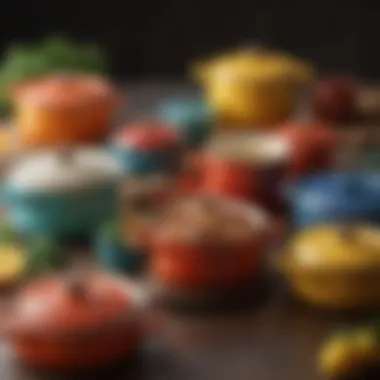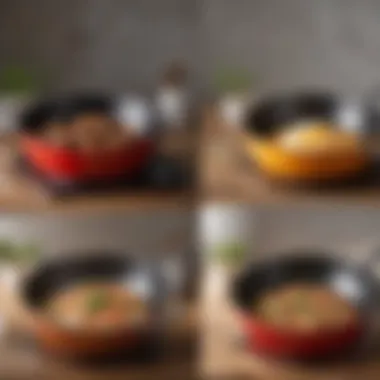Ceramic vs Teflon Cookware: A Detailed Comparison


Intro
In the realm of culinary tools, cookware plays a pivotal role in shaping cooking experiences. The material of your cookware can influence not only the efficiency of cooking but also the health and environmental factors surrounding meal preparation. Two of the most widely discussed options are ceramic cookware and Teflon, each with unique characteristics, advantages, and disadvantages.
As the design and usage of cookware evolve, understanding these materials is crucial for enhancing one's culinary journey. This guide aims to provide a comprehensive analysis of ceramic and Teflon cookware, delving into their properties, safety aspects, maintenance guidelines, and environmental impact. For culinary enthusiasts, making informed choices about cookware is essential to elevate the cooking experience.
Throughout this article, we will dissect key aspects, helping you determine which type of cookware aligns better with your cooking style and values. The objective is to equip you with knowledge that will aid in making safer and more efficient cooking choices.
Preamble to Cookware Materials
Cookware is an essential part of any kitchen. The materials used affect cooking performance, food safety, and even the longevity of the cookware. Choosing the right material can enhance cooking methods and meal outcomes. This section discusses various cookware options, highlighting their core characteristics.
Overview of Cookware Options
Today, a wide range of cookware materials exists. This includes stainless steel, cast iron, ceramic, and Teflon, each with unique properties.
- Stainless Steel: Known for its durability and resistance to rust, stainless steel is a staple in many kitchens. It heats evenly but may require more oil to prevent sticking.
- Cast Iron: This material retains heat exceptionally well, making it ideal for slow-cooking and frying. However, it can be heavy and requires special care to maintain.
- Ceramic Cookware: Often praised for its non-toxic surface, ceramic cookware provides good heat distribution. It is less prone to scratching compared to other materials.
- Teflon Cookware: This option is renowned for its non-stick capabilities, allowing for easy food release and minimal oil use.
Each of these materials comes with pros and cons that should be considered when making a selection.
Importance of Material in Cooking
The choice of cookware material directly influences cooking efficiency and food quality. For instance, non-stick surfaces like Teflon allow for healthy cooking by reducing the amount of oil needed. Conversely, materials like cast iron can add iron to food, potentially benefitting those with iron deficiencies.
Moreover, the cooking temperature is another key factor. Stainless steel, for example, can withstand high heat without warping, making it suitable for searing meats. Ceramic, however, may not tolerate rapid temperature changes, leading to cracking.
"Cookware is the foundation of cuisine. Understanding the properties of materials can transform cooking into an art."
Taking these considerations into account can lead to better culinary outcomes and healthier meals. Ultimately, understanding the fundamentals of cookware materials prepares the reader for a more informed choice, especially in the comparison between ceramic cookware and Teflon. The next sections will delve deeper into these materials, allowing for a thorough examination of their distinct attributes.
Understanding Ceramic Cookware
Ceramic cookware has gained popularity among culinary enthusiasts due to its unique advantages and properties. This section aims to examine the intricacies of ceramic cookware, providing vital information on its material composition, performance, safety, environmental concerns, and maintenance requirements. Understanding ceramic cookware is crucial for anyone who wishes to explore healthier, more sustainable cooking options while appreciating the nuances of modern culinary tools.
Composition and Manufacturing Process
Ceramic cookware is typically made from a blend of natural clay, minerals, and water. The mixture is shaped into various forms and then fired at high temperatures, which solidifies the material and creates a hard, non-porous finish. This process not only results in visually appealing products but also enhances their cooking capabilities. Many ceramic cookware pieces feature a glaze that adds an extra layer to the surface, improving non-stick qualities and durability.
The manufacturing process can vary between brands, influencing the final product's performance and safety. Some manufacturers incorporate natural or synthetic additives to either enhance durability or prevent sticking. It is crucial for consumers to verify the quality and safety standards of the ceramic cookware they choose to purchase.
Performance Characteristics
Heat Distribution
One notable characteristic of ceramic cookware is its heat distribution. Unlike some materials that may create hot spots, ceramic offers more even heat distribution, leading to better cooking results. This makes it a popular choice for various dish types, from sautéing to baking. The consistent heat helps prevent burning or uneven cooking, which can be particularly frustrating for those who want to achieve perfectly cooked meals.
However, it is essential to note that poor-quality ceramic cookware may still struggle with heat retention or distribution. Consumers should prioritize reputable brands to avoid these potential issues and enhance their cooking experience.
Cooking Temperature Range
Ceramic cookware can typically withstand medium to high cooking temperatures, although the specific range can vary depending on the brand and materials used. Most ceramic pieces can generally handle temperatures up to 450 degrees Fahrenheit. This range allows for versatility in cooking methods, including baking, frying, and boiling.


On the downside, sudden temperature changes may crack or damage lower-quality ceramic cookware, impacting longevity and performance. Thus, careful attention to cooking practices is advisable when using these tools.
Durability
The durability of ceramic cookware can be a double-edged sword. While high-quality ceramic can provide excellent resistance to wear and scratches, lower-grade options may weaken over time. This can affect not only performance but also safety. A well-cared-for ceramic piece can last years, provided it is not subjected to extreme conditions like metal utensils or rapid temperature changes. However, consumers should evaluate their usage habits alongside product quality to ensure they make a wise investment.
Safety Aspects
Toxicity Concerns
Safety is a critical consideration when choosing cookware. Ceramic cookware is generally touted as a healthier option, as it typically contains no harmful chemicals like PFOA or PTFE found in lower-quality non-stick products. This characteristic makes ceramic a preferred choice among health-conscious consumers.
Nonetheless, it is critical to choose products from reputable manufacturers. The glaze used on some ceramic cookware might contain heavy metals, which, if they leach, could pose health risks. Identifying certified and proven-safe options will enhance consumer confidence.
Health Benefits
Using ceramic cookware can offer several health benefits. Because it is made from natural materials, it provides a safer cooking alternative that does not leach harmful substances into food. Additionally, ceramic dishes often require less oil for cooking, which can lower overall fat and calorie intake—beneficial for both weight management and heart health.
The long-term use of ceramic cookware can also contribute to healthier meal preparation, as users may feel encouraged to adopt cooking methods that incorporate more whole foods, aligning with a nutritious lifestyle.
Environmental Sustainability
Biodegradable Elements
Ceramic cookware boasts an edge in sustainability due to its natural components. Specifically, clay and other minerals used in production are naturally occurring and biodegradable, reducing the environmental impact compared to synthetic materials. This advantage makes ceramic cookware a favorable option for eco-conscious consumers seeking to minimize their carbon footprint.
The production process can still entail energy consumption and waste generation. However, the use of sustainable materials places ceramic cookware much higher on the sustainability scale compared to plastic or heavy metals.
Impact on Natural Resources
The extraction and processing of natural clay can have implications for land and resource use. While we benefit from such a rich material, it is crucial to consider sustainable sourcing practices. Brands that engage in responsible extraction methods contribute to less environmental degradation, creating more eco-friendly products.
Maintenance and Care
Cleaning Techniques
Cleaning ceramic cookware can often be simpler than other options. Most ceramic pieces are dishwasher safe, but hand washing is usually recommended to preserve their longevity. A soft cloth or sponge with mild soap will often suffice, easing the burden of cookware maintenance.
Avoiding abrasive cleaners or metal utensils ensures the smooth surface remains intact, thus prolonging its life.
Longevity Tips
To extend the lifespan of ceramic cookware, certain habits can be helpful. Avoid subjecting it to extreme temperature changes, such as placing a hot pan directly into cold water. Moreover, proper storage—like stacking with protective layers—can minimize scratches and damage. Investing time in these practices pays off, as it enhances the overall durability and performance of ceramic products.
Examining Teflon Cookware
Teflon cookware has gained significant attention as one of the leading options in modern kitchens. It is essential to examine Teflon due to its popularity and distinctive features that cater to various cooking needs. This section outlines several elements including its composition, performance, safety concerns, environmental impact, and care methods. By understanding these aspects, readers can make informed decisions regarding their cookware selection.
Composition and Production
Teflon, known scientifically as polytetrafluoroethylene (PTFE), is a synthetic polymer that exhibits unique non-stick properties. Its production involves the polymerization of tetrafluoroethylene, a gas that is highly reactive. Under stable conditions, this gas transforms into a solid material. The resulting Teflon coating is widely used in cookware for its distinct characteristics, making it a well-regarded choice.
Performance Features


Non-Stick Properties
Non-stick properties of Teflon are one of its most celebrated attributes. This characteristic allows food to release easily from the surface without sticking. This greatly minimizes the need for excessive oils and fats, thus promoting healthier cooking options. However, while Teflon works exceptionally well when new, wear and tear over time may diminish these qualities, requiring careful usage to prolong its life.
Temperature Tolerance
Temperature tolerance is another vital aspect of Teflon cookware. Generally, Teflon can withstand cooking temperatures up to about 500°F (260°C). This range allows for various cooking techniques such as frying and sautéing without degrading the non-stick surface. Still, exceeding these temperatures can lead to the release of toxic chemicals, making it important to adhere to recommended cooking practices.
Scratch Resistance
Scratch resistance in Teflon cookware is a topic of ongoing discussion. While Teflon often claims to be scratch-resistant, it can still be vulnerable to damage from metal utensils. This can compromise its non-stick capabilities. Opting for silicone or wooden utensils can help preserve the integrity of the surface, ensuring longevity.
Safety Concerns
Chemical Safety
Chemical safety in Teflon cookware has raised concerns due to the production process which may involve the use of perfluorooctanoic acid (PFOA), a substance previously linked to environmental and health issues. However, most reputable manufacturers have phased out PFOA, enhancing the safety of their products. It is vital for consumers to check for this certification when purchasing Teflon cookware.
Health Risks
Health risks associated with Teflon arise predominantly from overheating, which could release harmful fumes. These fumes can cause flu-like symptoms known as "polymer fume fever", particularly in pet birds, who are more sensitive to these chemicals. Awareness and adherence to safe cooking practices are necessary to minimize any potential health risks.
Environmental Impact
Manufacturing Footprint
The manufacturing footprint of Teflon is also a significant concern. The production process can be environmentally taxing, with potential pollution from chemicals used in manufacturing. Recycled materials are not commonly used in Teflon production, raising sustainability questions.
Disposal Issues
Disposal issues pertaining to Teflon cookware relate to its environmental persistence. Teflon is not biodegradable, leading to potential long-term waste accumulation. Proper disposal strategies are essential, though they are often neglected. Seeking out recycling programs specifically for Teflon can help mitigate this impact.
Care Instructions
Proper Cleaning Methods
Proper cleaning methods for Teflon cookware emphasize the importance of using gentle detergents and non-abrasive sponges. Scrubbing pads can damage the non-stick surface, leading to compromised performance. Hand washing is recommended over dishwasher cleaning to preserve Teflon’s integrity.
Storage Recommendations
Storage recommendations suggest storing Teflon cookware stacked with care. Using protective liners between pans can prevent scratching. By keeping cookware well-maintained and properly stored, the lifespan of Teflon products can be extended, allowing consumers to enjoy their full benefits for a long period.
Comparative Analysis
In today’s culinary landscape, understanding the intricacies between cookware options is vital. The comparative analysis of ceramic cookware and Teflon serves as a roadmap for consumers, guiding them through key attributes that directly impact cooking effectiveness and overall experience. The merit of this analysis lies not only in deducing which material is superior but in highlighting the specific needs and preferences of the user. By deciphering unique features, benefits, and potential drawbacks of each type, consumers can make informed decisions tailored to their cooking styles and health considerations.
Performance Comparison
When it comes to cooking, performance is essential. Ceramic cookware typically excels in heat retention and even heating, which can result in better cooking outcomes. The ability of ceramic materials to provide uniform heat distribution enhances the flavors of dishes and reduces the chance of overcooking certain areas. In contrast, Teflon cookware is renowned for its non-stick properties, allowing for easy release of food and simple clean-up. However, it can struggle with high-heat cooking techniques, with temperatures above 500°F potentially damaging the non-stick surface.
In practical terms, one might find ceramic cookware preferable for slow cooking methods or recipes requiring temperture control. Teflon shines in fast cooking scenarios where food must not stick, demonstrating its strengths in flipping omelets or sautéing vegetables. Ultimately, the effectiveness of either cookware depends largely on the cooking method and personal preference in texture and flavor outcomes.
Safety Evaluation


Safety considerations are paramount for both cookware types. Ceramic cookware is typically regarded as safe, free from harmful chemicals. However, one must be vigilant about the quality of the ceramic coating applied, which could contain harmful substances in lower-quality materials. It is advisable to opt for reputable brands known for their rigorous safety standards.
On the other hand, Teflon has faced scrutiny over chemical safety, particularly concerning perfluorooctanoic acid (PFOA). While current Teflon products are PFOA-free, concerns remain regarding thermal breakdown at high temperatures. Consumers should assess their cooking techniques to mitigate these risks, ensuring that their cookware is used within specified heat ranges.
Environmental Considerations
In today’s eco-conscious society, the environmental impact of cookware materials cannot be overlooked. Ceramic cookware can be considered more environmentally friendly due to its natural materials and potential for biodegradability. Additionally, many ceramic brands utilize sustainable practices, making them appealing to eco-aware consumers.
Conversely, the manufacturing process of Teflon can entail significant environmental consequences. The production involves chemical processes that can contribute to pollution if not managed properly. While innovations are being made toward reducing this footprint, buyers should research and choose brands that prioritize sustainable operations.
Cost-Effectiveness
Cost is an essential element of cookware decision-making. Generally, ceramic cookware tends to have a higher upfront cost compared to Teflon. However, its durability and longevity often make it a more cost-effective option in the long run. High-quality ceramic can resist scratching and maintain performance without needing frequent replacement.
Conversely, while Teflon initially appears cheaper, repeated replacements due to wear and tear can make it less economical over time. Evaluating the total cost of ownership, rather than just the purchase price, aids in comprehending the true value of cookware selections.
Consideration: Analyze your cooking habits and select cookware that fits your lifestyle requirements.
Taking a comprehensive look at performance, safety, environmental impact, and cost-effectiveness, this comparative analysis supports readers in navigating the complexities of cookware selection. In understanding each aspect, consumers can confidently choose between ceramic and Teflon, ensuring better cooking experiences for years to come.
Consumer Preferences
Consumer preferences play a crucial role in shaping the cookware market. Understanding what drives choices people make regarding ceramic cookware and Teflon is essential for both manufacturers and consumers. As awareness of health and environmental issues increases, consumers are becoming more discerning about the materials they use in kitchens. This section will highlight significant trends and user experiences that impact these choices.
Market Trends
Recent years have shown a growing interest in healthier cooking options, with many buyers opting for materials believed to be safer for food preparation. Ceramic cookware has gained recognition as an alternative to traditional non-stick options due to its perceived lack of harmful chemicals. Specifically, many customers prefer ceramic for its non-toxic nature, especially since it does not release harmful substances when heated.
Moreover, eco-conscious consumers are increasingly considering the environmental impact of their cookware. Brands that emphasize sustainability in sourcing and manufacturing processes are more attractive in today's market. This includes the lack of harmful pollutants in production, and the recyclability of materials post-use. According to recent market research, sales growth in ceramic cookware is positively correlated with rising environmental awareness among consumers.
On the other hand, Teflon remains popular for its superb non-stick properties. However, it must contend with safety concerns regarding chemicals like PFOA, which have lost favor with many customers. Those who do choose Teflon often cite ease of cleaning and long-lasting non-stick surfaces.
User Experiences
Consumer feedback reveals varied experiences with both ceramic cookware and Teflon. Users of ceramic cookware often report satisfaction with its cooking performance and safety, complimenting its ability to retain heat while providing even cooking. Many appreciate that it can withstand higher temperatures, making it versatile for different dishes. However, a common caution is regarding its durability. Users sometimes express disappointment when ceramic chips or scratches occur.
In contrast, Teflon users frequently praise the effortless experience of cooking and cleaning with non-stick surfaces. However, some express concerns about the longevity of the non-stick coating and potential for scratching if using metal utensils.
"I switched to ceramic because I wanted to avoid any chemicals. So far, I am pleased with the heat distribution, but I am careful not to use metal utensils."
Feedback also indicates that price plays an essential part in consumer choices. Generally, ceramic cookware is perceived as higher-priced compared to Teflon, but many believe it offers better value in terms of health and durability.
In summary, understanding consumer preferences in cookware extends beyond just features. It involves a complex interplay of health consciousness, sustainability, and personal experiences that shape choices in today’s culinary landscape.
Closure
The conclusion of this article highlights the necessity of understanding cookware options, particularly ceramic and Teflon. This understanding empowers consumers to make informed decisions regarding their culinary tools. As the cooking landscape evolves, the choice of cookware significantly impacts not just the enjoyment of cooking, but also health and safety considerations.
Choosing between ceramic and Teflon involves weighing various factors. Each type has its unique strengths and weaknesses, which must be considered carefully. For instance, ceramic cookware excels in aesthetic appeal and features a non-reactive surface, making it ideal for healthy cooking. In contrast, Teflon cookware offers unmatched convenience due to its superior non-stick properties, though it comes with specific safety concerns.
Moreover, this conclusion underscores that environmental impact is one of the primary considerations in cookware selection today. As sustainability becomes a core value for many consumers, understanding the lifecycle of cookware can guide choices that align with personal and societal values.
"The right cookware can make a significant difference in your cooking experience, impacting flavor, cooking efficiency, and health outcomes."
Final Thoughts on Cookware Selection
In summary, selecting cookware should extend beyond brand names or mere aesthetics. It requires a deeper examination of factors such as functionality, safety, and overall impact on cooking. The right choice can enhance the cooking experience and even affect health over time. Consider personal cooking habits, preferred cuisines, and even environmental concerns when making a decision.
Ultimately, whether one opts for ceramic or Teflon, awareness of what each material offers in terms of performance, safety, and maintenance is crucial. It allows anyone, from novice cooks to seasoned chefs, to elevate their culinary practices, ensuring that every meal prepared is not only delicious but also safe and sustainable.



